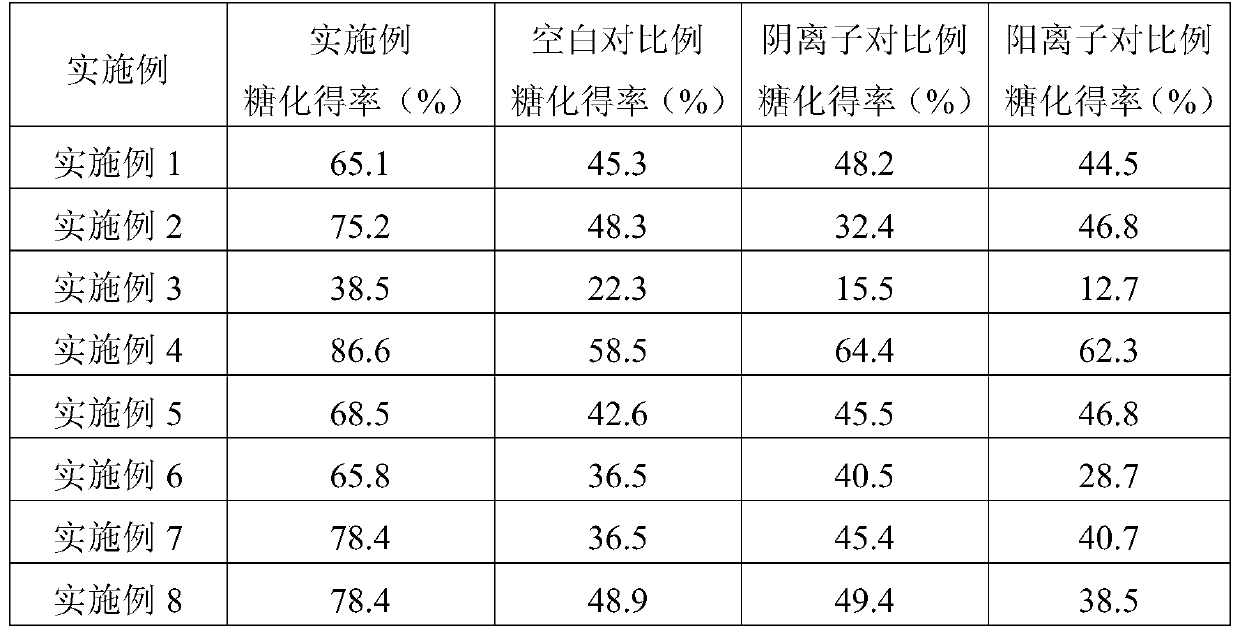A method for improving lignocellulose enzymatic saccharification yield
A technology of lignocellulase and lignocellulose, which is applied in the directions of biofuel and fermentation, can solve the problems of low fermentable sugar concentration, low enzymatic hydrolysis efficiency and high production cost, achieve rich sources and improve enzymatic hydrolysis and saccharification yield , the effect of price renewable
- Summary
- Abstract
- Description
- Claims
- Application Information
AI Technical Summary
Problems solved by technology
Method used
Image
Examples
Embodiment 1
[0033] Take 100 parts by mass of PH101 microcrystalline cellulose and add it to 5000 parts by mass of an acetic acid-sodium acetate buffer solution with a pH of 4.5 and an ionic strength of 25 mmol / L. Add 0.05 parts by mass of sodium lignosulfonate and 0.001 parts by mass of phenyltris Methyl ammonium bromide, and then add 5FPU / g cellulase based on the content of dextran in the cellulose, and react at 50°C for 72h. After the reaction, the cellulose hydrolyzate was obtained by solid-liquid separation, and the glucose content was measured by a biosensor analyzer. The statistical results are shown in Table 1.
Embodiment 2
[0035] Take 100 parts by mass of eucalyptus pretreated by dilute acid method, add 2500 parts by mass of phosphate buffer solution with pH 6.0 and ionic strength of 100mmol / L, add 10 parts by mass of sodium lauryl sulfate and 1 part by mass Decyltrimethylammonium bromide, and then add 5FPU / g cellulase based on the glucan content in lignocellulose, and react at 40°C for 72h. After the reaction, the lignocellulose hydrolysate was obtained by solid-liquid separation, and the glucose content was measured by a biosensor analyzer. The statistical results are shown in Table 1.
Embodiment 3
[0037] Take 100 parts by mass of pine wood pretreated by the dilute acid method and add it to 2500 parts by mass of acetic acid-sodium acetate buffer solution with a pH of 5.0 and an ionic strength of 50 mmol / L, and add 100 parts by mass of sodium dodecylbenzene sulfonate and 100 parts by mass of dodecyltrimethylammonium chloride, and then add 10FPU / g cellulase based on the glucan content in lignocellulose, and react at 50°C for 72h. After the reaction, the lignocellulose hydrolysate was obtained by solid-liquid separation, and the glucose content was measured by a biosensor analyzer. The statistical results are shown in Table 1.
PUM
| Property | Measurement | Unit |
|---|---|---|
| ionic strength | aaaaa | aaaaa |
Abstract
Description
Claims
Application Information
 Login to View More
Login to View More - R&D
- Intellectual Property
- Life Sciences
- Materials
- Tech Scout
- Unparalleled Data Quality
- Higher Quality Content
- 60% Fewer Hallucinations
Browse by: Latest US Patents, China's latest patents, Technical Efficacy Thesaurus, Application Domain, Technology Topic, Popular Technical Reports.
© 2025 PatSnap. All rights reserved.Legal|Privacy policy|Modern Slavery Act Transparency Statement|Sitemap|About US| Contact US: help@patsnap.com

